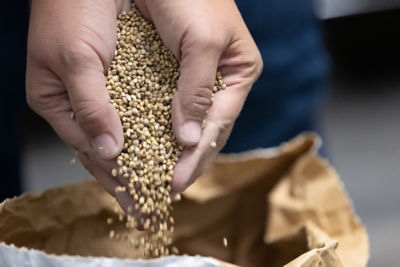Click here to download a PDF version of this Cultivation Insights article.
» Regular and effective greenhouse sanitation can help reduce disease and pest problems.
» Thorough cleaning of greenhouses between crop cycles helps crops get off to a good start.
» Preventing the introduction and spread of pathogens during the cropping period helps keep plants healthy and productive.
Adhering to recommended greenhouse sanitation protocols helps protect production and product quality by helping reduce disease and pest problems. Proper sanitation practices can help reduce the presence of pathogens and help prevent the introduction and spread of pathogens in the greenhouse. Greenhouses have warm, moist environments that are favorable for the survival and reproduction of many plant pathogens. Pathogens often survive inorganic matter, such as infected plant tissues, crop debris, and growth media. Good sanitation practices focus on helping to remove sources of pathogen inoculum and preventing their reintroduction. Effective practices can help reduce the need for chemical controls and help improve the effectiveness of chemical, cultural, and genetic management strategies by helping to lower disease pressure in the greenhouse. Sanitation may also help reduce safety hazards, such as the presence of slippery films of algae on concrete walkways.1,2,3,4
CLEANING THE HOUSE
Thoroughly cleaning greenhouses between each cropping cycle, or at lease once a year, is highly recommended.3 Begin with a fallow and empty greenhouse with all plants, weeds, and crop debris removed from the house. Start cleaning shortly after the end of the crop season.1,2 Start by using a shop vacuum to remove soil, plant debris, and other matter from benches and floors. Use a power-washer (pressurewasher) to clean all structures and surfaces with soap and water, starting at the top of the house and working downward.1,3,5
Removing organic matter increases the effectiveness of cleaning and sanitizing agents (Table 1). Scrub-brushes may be needed to remove dirt from benches and other structures. Rinse away detergents and debris before treating surfaces with disinfecting/sanitizing agents. Recommended contact times and the need to rinse after treatment vary with the sanitation products used, so follow all product labels and directions carefully.
Porous surfaces, such as wooden benchtops, are usually more difficult to sanitize and may require more time and attention to remove dirt and biofilms. Wire or laminate (non-porous) benches are generally easier to clean and disinfect. Where needed, install and maintain weed barriers over bare dirt and gravel floors. Soak breaker nozzles or heads with disinfectant and rinse before use. Clean irrigation systems and flush irrigation lines.1,3

PERSONNEL
Following sanitation protocols during the production season can help minimize the introduction and spread of pathogens and pests in the greenhouse. Strategies of exclusion focus on preventing the introduction of pathogens and pests. One concern is the introduction and spread of pathogens by workers entering and working in the greenhouse. Pests and pathogens can be carried on dirty clothing, shoes, and hands.4 It is important to educate workers about the dangers of diseases and pests and to train them in the required sanitation protocols.
Restricting the entry into greenhouses to necessary personnel can help minimize the threat of bringing in pathogens.5 Placing decontamination stations outside the greenhouse can make it easier for workers to clean up before entry. These stations can include brushes and a hose or power washer to clean shoes, a sink or basin with soap and water for hand washing, hand sanitizer, paper towels or a supply of hand towels, and a trash can. Some operations may want to provide removable/disposable clothing, gloves, hair covers, and shoe covers.
Footbaths or mats containing a sanitizing agent can be placed at greenhouse entrances and used to sanitize shoes after removing soil. The sanitizers should be changed regularly, at least daily.2,3 Handwashing stations should also be conveniently located in the greenhouse to encourage regular handwashing when working with plants or after using the toilet. Workers should wash their hands with soap and clean water, remove soil from under fingernails, rub hands together for at least 20 seconds, and dry with a paper towel.4 If disposable gloves are used, they should be changed regularly, at least between tasks or after touching diseased plants. Avoid using cloth or leather gloves.
The need for allowing visitors to enter the greenhouse will depend on the business practices of the operation. Employees should visually inspect the visitors’ shoes and clothing for evidence of contamination. Clean boots or shoe covers can be provided for visitors. Visitors should be asked to wash their hands with soap and water before entry. They should also be asked if they have recently visited locations where plant pests and pathogens may have been present.4
INFESTED MATERIAL
Help prevent introducing pathogens on new plant material by purchasing certified, disease-free seed and planting stock. Quarantine new planting material in an isolated area and inspect the plants for insect pests and symptoms of disease periodically before moving them into the production areas of the house.5 Heavily infected plants and plants with untreatable diseases should be removed from the greenhouse to help minimize the chances of disease spread. Infested plant debris and growth media, weeds, volunteer plants, cuttings, and culled plants from the affected area should also be removed from the house. Place contaminated material in plastic bags or covered trash cans before transporting it through the house. Locate burn piles, cull piles, or bury pits at least 100 yards from the greenhouse, preferably downwind and down-slope. Do not compost diseased material because incomplete composting can allow pathogens to survive the process and be spread in the resulting compost.2
IN-SEASON CLEANING
Regularly clean floors and benches, removing all soil/planting media and plant debris. Moist growth media and plant debris can be a source of pathogens, algae, fungus gnats, and shoreflies.1,2 Use only new pots and flats or clean and disinfect them before reuse. Avoid reusing containers that held diseased plants. Before reusing containers, wash them thoroughly to remove all organic matter and soil, and then treat with a disinfectant/sanitizer. Do not reuse growth media that has fallen on the floor, as it may have become contaminated with pathogens.1,2,5
Clean and disinfect tools and equipment that come into contact with plants and growth media after each use. Store tools in a clean, dry, dedicated storage area. Do not leave tools on benches or on the ground. Clean and disinfect any tools that touch the floor before allowing them to come into contact with plants or plant preparation areas. Get rid of damaged tools, as nicks and scratches can serve as places where pathogens are protected from cleaning and sanitizing efforts. Clean tools with soap and water to remove soil and organic matter before disinfecting because organic matter can reduce the efficacy of the sanitizing agents. Some tools can be heat sterilized using flame or steam. Flaming is usually only used with small tools. Steam treatment can also be used on larger tools and equipment. Chemical sanitizers are commonly used to disinfect tools, but some sanitizing agents may harm plants if tools are not thoroughly rinsed. Some sanitizing agents can also cause corrosion orrusting of tools.4,5
PREVENTING DISEASE SPREAD
To reduce the spread of diseases on hoses, nozzles should be kept off of the ground at all times, and dragging hoses across the floor should be avoided as this can move infested soil. Plants should always be irrigated with pathogen-free water.1,2,5 Growth media should be kept in a clean and protected area, and field soil should not be brought into the greenhouse. Do not reuse growth media/potting mixes. Keep trashcans in the greenhouse covered and empty them regularly.1,2
SOURCES
1 Smith, T. 2015. Cleaning and disinfecting the greenhouse. UMass Extension Greenhouse
Crops and Floriculture Program.
https://ag.umass.edu/greenhouse-floriculture/fact-sheets/cleaning-disinfecting-greenhouse.
2 Gauthier, N. and Seebold, K. 2021. Greenhouse sanitation. University of Kentucky, Plant
Pathology Fact Sheet, PPFS-GH-04.
3 Gauthier, N., Kight, J., Owen, W., and Anderson, S. 2020. Cleaning & sanitizing commercial
greenhouse surfaces. University of Kentucky, Plant Pathology Fact Sheet, PPFS-GH-07.
4 Galanti, R. and Lutgen, H. 2021. Greenhouse and nursery sanitation: Tools, equipment,
workers, and visitors. Extension Publication OF-54. College of Tropical Agriculture and Human
Resources, University of Hawaii at Manoa.
5 Getter, K. 2014. Greenhouse sanitation is the first step in managing pests and pathogens.
Michigan State University, MSU Extension.
https://www.canr.msu.edu/news/greenhouse_sanitation_is_the_first_step_in_managing_
pests_and_pathogens.
Websites verified 10/03/2023
ADDITIONAL INFORMATION
For additional agronomic information, please contact your local seed representative.
Performance may vary, from location to location and from year to year, as local growing, soil and weather conditions may vary. Growers should evaluate data from multiple locations and years whenever possible and should consider the impacts of these conditions on the grower’s fields. The recommendations in this article are based upon information obtained from the cited sources and should be used as a quick reference for information about greenhouse cucumber production. The content of this article should not be substituted for the professional opinion of a producer, grower, agronomist, pathologist and similar professional dealing with this specific crop.
BAYER GROUP DOES NOT WARRANT THE ACCURACY OF ANY INFORMATION OR TECHNICAL
ADVICE PROVIDED HEREIN AND DISCLAIMS ALL LIABILITY FOR ANY CLAIM INVOLVING
SUCH INFORMATION OR ADVICE.
5010_290550 Published 10/11/2023



